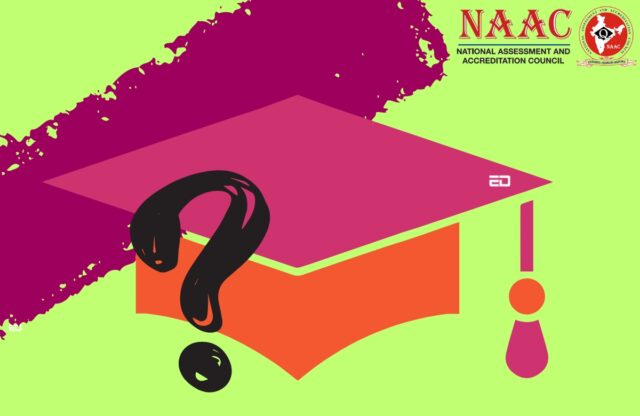National Assessment and Accreditation Council is an autonomous body under the University Grants Commission. This body assesses the quality of India’s higher educational institutions and awards grades to them.
Recently, the chairman of NAAC raised allegations against the working of the body and was demanding an independent probe. He eventually resigned from his post on March 5.
What Does NAAC Grading Mean For Institutes?
The National Assessment and Accreditation Council (NAAC) was established in 1994. This institution follows a multi-stage assessment process before providing grades to colleges and universities.
The NAAC has special requirements for accreditation. The Higher Educational Institution applying for accreditation should have a record of at least two batches of students, who have graduated from the institute, or the college must have been existing for 6 years, or whichever is earlier.
Institutes that pass this bar are eligible to submit a quality assessment application, based on which the NAAC determines if any institute can be accredited or not. The fees for the application exceed 6.5 lakhs.
The applying institute is required to submit a self-study report specifying quantitative and qualitative metrics. This data is then reviewed by expert teams of NAAC in the form of spot visits by peer teams constituted of assessors across Universities.
The grades issued by NAAC range from A++ to D. The D grade symbolizes that the university/institution is not accredited. Seven criteria serve as the basis for accreditation- research and innovation, infrastructure, student support, governance, and others.
Also Read: The Reason Behind IIT Madras Student’s Death By Suicide; Second In A Month

What Are The Loopholes?
Bhushan Patwardhan, the chairman of NAAC, in his letter of intent to resign said that he had previously raised concerns about the possibility of vested interests, malpractices, and nexus among the individuals involved in the grading process.
This leads to the manipulation of verification and team visit processes. He alleged that these malpractices led to the “awarding of questionable grades” by the NAAC.
Patwardhan met University Grants Commission Chairman Jagadish Kumar and raised this issue. He talked to the Chairman regarding the findings of the inquiry he commissioned after taking charge.
He also proposed an independent probe by high-level agencies to look into the affairs of NAAC. “But all in vain. Moreover, my communication with you during the last couple of months has been conveniently ignored,” he wrote. On 5th March, Patwardhan resigned.
Findings Of The Enquiry
Director of Information and Library Network, JP Singh Joorel, headed the inquiry committee. This committee concluded that there were irregularities in the accreditation process.
According to The Indian Express, ” The council’s IT system was discovered to be compromised. The panel stated that assessors were also assigned arbitrarily and that these procedures might lead to conflicts of interest.“
The panel found that approximately 70% of the 4000 assessors have not got a chance to visit sites as much as the rest 30%. Also, individuals that had no authority had access to the NAAC’s internal system.
Last month, Union Minister of State for Education Subhas Sarkar told the Lok Sabha that at least 695 universities and over 34,000 colleges across the country are operating without NAAC accreditation.
The CAG pointed out the mismatch between the report and marks provided to the institutes. For instance, the expert panel, which visited an institute at Bellampalli in Telangana, had mentioned in its report that waste was burnt on the premises, causing air pollution.
However, this institute received full marks for waste management. Similarly, the expert panel’s report praised a college in Mumbai for becoming a plastic-free campus. However, this college was awarded one mark for waste management.
NAAC’s Defence
NAAC put out a press release that emphasized that their operations are transparent, technology-driven, adequate, and automated. It provided data on the active assessors. It said, “ out of the total pool of 4,686 active assessors, 3,075 assessors have accepted the peer team visit invitations, which is roughly around 67 percent of the database.”
The questions by CAG were also addressed in the press note. It said that the CAG report was not final and changes suggested by the CAG are being incorporated by NAAC.
Despite having a strict process of providing a grade to the HEIs, it is of no use in the improvement of the educational system. The grading system has a lot to do with the reputation of colleges.
These malpractices and carelessness in awarding grades lead to the making and breaking of the reputation of the institutes in India. It’s time that the system gets free from malpractices, and serious reforms are brought about in the education system.
Image Credits: Google Images
Feature image designed by Saudamini Seth
Sources: The Indian Express, Telegraph India, Business Standard
Find the blogger: Katyayani Joshi
This post is tagged under: education, grading, NAAC, malpractices, colleges, universities, rankings, chairman, inquiry, internal committee, UGC, CAG report, expert panels, on-spot visits, carelessness, Higher Educational Institutions
Disclaimer: We do not hold any right, or copyright, over any of the images used. These have been taken from Google. In case of credits or removal, the owner may kindly mail us.
Other Recommendations:
ResearchED: Implication Of Raising The Age of Marriage to 21